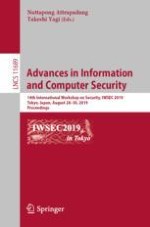2019 | OriginalPaper | Buchkapitel
Bidirectional Asynchronous Ratcheted Key Agreement with Linear Complexity
verfasst von : F. Betül Durak, Serge Vaudenay
Erschienen in: Advances in Information and Computer Security
Aktivieren Sie unsere intelligente Suche, um passende Fachinhalte oder Patente zu finden.
Wählen Sie Textabschnitte aus um mit Künstlicher Intelligenz passenden Patente zu finden. powered by
Markieren Sie Textabschnitte, um KI-gestützt weitere passende Inhalte zu finden. powered by
Abstract
 messages has complexity
messages has complexity
 in general.
in general. ) with formal security notions. We provide a simple security model and design a secure
) with formal security notions. We provide a simple security model and design a secure
 scheme using no key-update primitives, no random oracle, an with
scheme using no key-update primitives, no random oracle, an with
 complexity. It is based on a public-key cryptosystem, a signature scheme, one-time symmetric encryption, and a collision-resistant hash function family. We further show that
complexity. It is based on a public-key cryptosystem, a signature scheme, one-time symmetric encryption, and a collision-resistant hash function family. We further show that
 (even unidirectional) implies public-key cryptography, meaning that it cannot solely rely on symmetric cryptography.
(even unidirectional) implies public-key cryptography, meaning that it cannot solely rely on symmetric cryptography.







